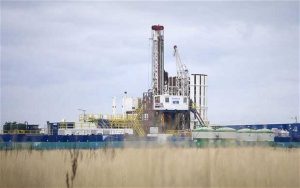
by Grant Ferguson1 and Sian Loveless2
- Department of Civil, Geological and Environmental Engineering, University of Saskatchewan
- British Geological Survey, Cardiff, Wales
The differences between the English* and Canadian experiences of unconventional hydrocarbon development were apparent at a meeting co-hosted by the British Geological Survey, Geological Society of London and IAH in London in July 2018.

Attendees at the Use of the Deep Subsurface in the UK conference in July 2018 (Photograph by Barnaby Harding).
England has been in the exploration stage of shale gas since 2008 and, to date, only a handful of wells have been drilled and the first horizontal test frack began in Lancashire in October 2018. In contrast, in Saskatchewan, Canada, which is home of the northern portion of the Bakken play, over 250,000 oil and gas wells have been drilled since the 1950s.

Population density is low northwestern North Dakota and southeastern Saskatchewan, but satellite imagery shows light from oil and gas development in the Bakken Formation (from NASA Earth Observatory).
What are the reasons for such a stark contrast? In both cases hydrocarbon rights are predominantly owned centrally, by either the Province (80%) or the Crown and licensed through the UK Government. Recent mapping and a series of reports by the BGS has suggested some potential for a range of hydrocarbons, including unconventional resources. However, an in-depth review process to be able to drill and test an exploration well in England may take years, owing to the multiple agencies and authorities involved in the decision making (Whitton, et al., 2017) and may encounter considerable controversy. There have been similar concerns about oil and gas development in Canada, which are highlighted by a review by the Canadian Council of Academies (Cherry et al., 2014). However, this has happened following decades of oil and gas production and has not impeded development in western Canada. In Saskatchewan, production wells are typically permitted within a matter of a few weeks and there are rarely comments from the public. In addition, population density is vastly different; England had a population density of 401 people per square km in 2010 (link) versus less than 4 people per square km in Saskatchewan (link). However, the conference highlighted that other, hydrogeological and geological factors may also be important, and the state of hydrogeological knowledge is a key factor.
Data from oil and gas wells drilled in Saskatchewan, such as stratigraphy, volumes of produced fluids and fluid chemistry is available to the public after a short confidentiality period. This has allowed for mapping of the subsurface and hydrogeological analyses over many parts of the region. Few impacts to groundwater have been documented, although monitoring is relatively sparse in Saskatchewan with only 70 monitoring wells over an area of 651,900 km², roughly twice the size of the UK. The majority of documented contamination incidents associated with oil and gas production are surface spills of either oil or produced waters. Flowback and produced waters are typically injected back into the subsurface. Strata used for disposal have been well characterized in most areas due to exploration and production activities by the oil and gas industry. There is some uncertainty about the long-term fate of injected fluids.
The biggest unknown in Saskatchewan and many other areas with extensive histories of oil and gas production is the nature of the intermediate zone. This interval, which is situated between the deepest aquifer capable of supplying potable water and the oil and gas producing zone, is typically data-poor because of a lack of investigation and monitoring. Base of groundwater protection mapping has not been done comprehensively for most of Saskatchewan. However, the presence of thick Cretaceous shales are thought to provide adequate hydraulic separation between oil and gas producing zones and overlying fresh groundwater supplies. Large scale faults are uncommon in Saskatchewan, aside from collapse features related to the dissolution of the Prairie Evaporite. The most likely pathway for contaminants to reach the surface in most cases is through poorly completed or abandoned wells. Leakage of methane through wells appears to be fairly common, but it is unclear how widespread upward migration of poor quality groundwater might be.
Onshore oil and gas is not new to the UK – it has a 150 year history of oil and gas production and there are currently 250 producing wells at 120 sites (link). In the 1980s the BGS compiled temperature and chemistry data, where available, for over 1150 sites (Rollin, 1987) as part of an investigation into deep geothermal energy, although the median depth was only 1000 m, still providing a very limited window into the subsurface, particularly when considering the variability of geological settings resulting from its complex structural history. For example, the basin size in the UK is on the order of ~40,000 km2 and has undergone multiple periods of deformation. Conversely, Western Canada Sedimentary Basin, which covers large parts of Saskatchewan and Alberta, has an area of the 1,400,000 km2.and is relatively undeformed in Saskatchewan. The decision making process must therefore be more site specific in England.

Population density is low northwestern North Dakota and southeastern Saskatchewan, but satellite imagery shows light from oil and gas development in the Bakken Formation (from NASA Earth Observatory).
In relation to groundwater, possible pathways from hydraulic fractures initially received most public attention in the UK. However, legislation (the Infrastructure Act, 2015) means that High Volume High Pressure hydraulic fracturing must take place deeper than 1000 m below the land surface – very few hydraulic fractures likely bridge this distance (Davies et al., 2014). The relatively high density of faults across all of the basins (resulting from this complex geological history) may be more of a concern if they could form permeable pathways since they tend to be longer, although the potential for flow along these faults is largely unknown. As in Canada, well casing and integrity is also a possible issue, but there are stringent controls on this – nevertheless, horizontal drilling may pose more of a problem in some instances (Bachu and Watson, 2009).
In England, all groundwater must be protected (Water Framework Directive, 2000) for human use/ecosystems. If little is known about the conditions in the subsurface, then the precautionary principle must be applied. In practice, however, depths within 400 m of the land surface –depths that most groundwater is abstracted from – is used a default maximum depth. In North America, some jurisdictions define a base of groundwater protection based on depth but some may also do this on salinity (Lemay, 2008; DiGiulio, et al., 2018). There were discussions at the conference on how the depth of groundwater should be defined.
The conference provided a useful forum within which to share experience from North America, and the advanced Bakken Play in Canada, with delegates from the UK hydrogeology industry. It was clear, however, that while there is a lot of learning to be done from these examples, due to the differences both in legislation and geology, the UK hydrogeology community should not use these examples as a direct analogue for the UK industry.
* The conference addressed use of the deep surface in the UK, but groundwater legislation discussed here applies to England only
References
Bachu S, Watson TL (2009) Review of failures for wells used for CO2 and acid gas injection in Alberta, Canada. Energy Procedia 1: 3531-3537
Cherry J, Ben-Eli M, Bharadwaj L, Chalaturnyk R, Dusseault MB, Goldstein B, Lacoursière J-P, Matthews R, Mayer B, Molson J (2014) Environmental Impacts of Shale Gas Extraction in Canada. The Expert Panel on Harnessing Science and Technology to Understand the Environmental Impacts of Shale Gas Extraction Ottawa: Council of Canadian Academies.
Davies RJ, Mathias SA, Moss J, Hustoft S, Newport L (2012). Hydraulic fractures: How far can they go? Marine and Petroleum Geology. 37: 1-6
DiGiulio DC, Shonkoff SB, Jackson RB (2018) The need to protect fresh and brackish groundwater resources during unconventional oil and gas development. Current Opinion in Environmental Science & Health 3: 1-7
Infrasturcture Act (2015). C.7. Part 6. Other provision about onshore Petroleum, Section 50. http://www.legislation.gov.uk/ukpga/2015/7/section/50/enacted
Lemay TG (2008) Description of the Process for Defining the Base of Groundwater Protection, Edmonton, Alberta, pp. 27.
Rollin KE (1987) Catalogue of geothermal data for the land area of the United Kingdom. Third revision: April 1987. Investigation of the geothermal potential of the UK. British Geological Survey.
Water Framework Directive (2000) Water Framework Directive. Common Implementation
Whitton J, Brasier K, Charnley-Parry I, Cotton M (2017) Shale gas governance in the United Kingdom and the United States: Opportunities for public participation and the implications for social justice. Energy research & social science 26: 11-22
